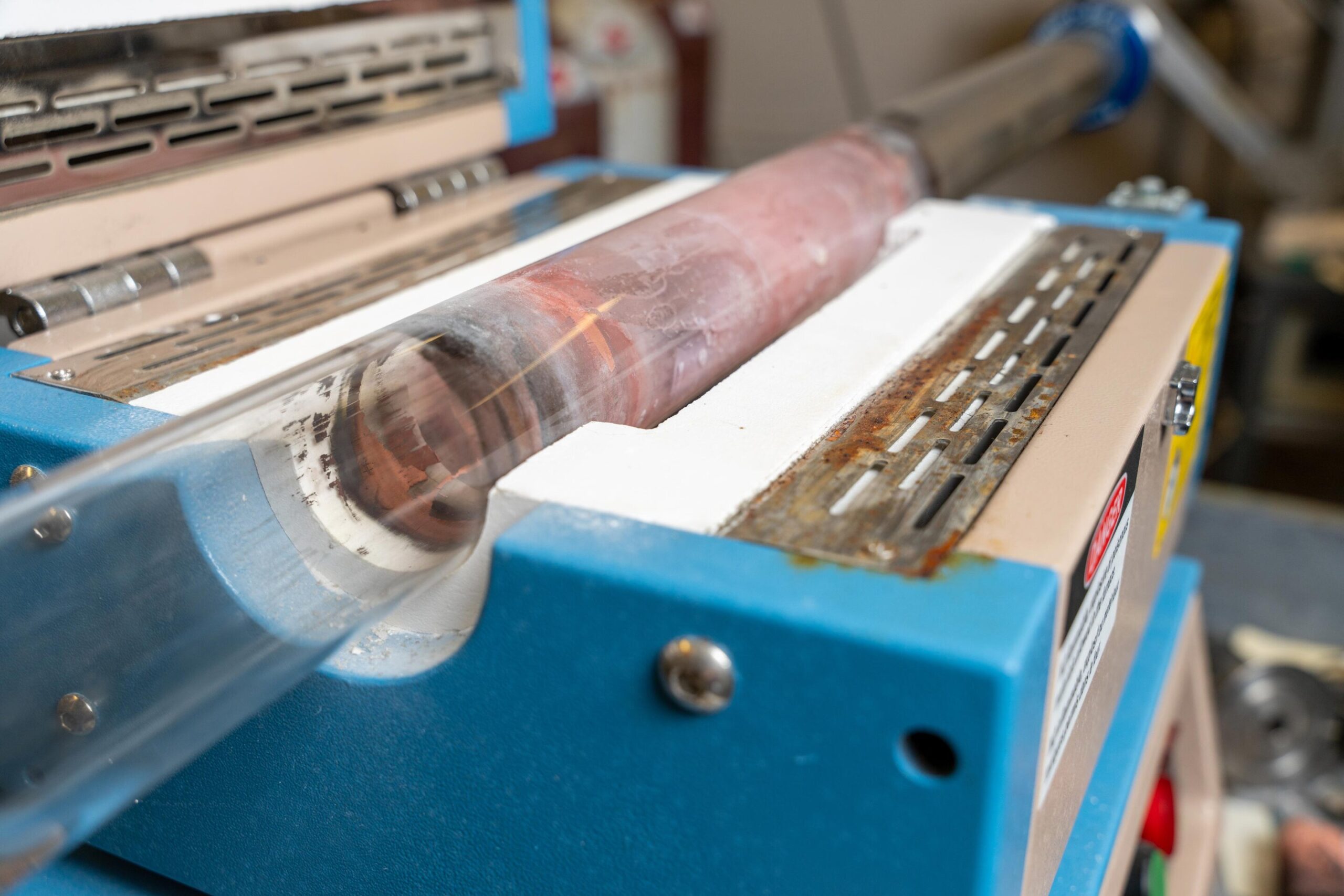Tech
Pure metallic gel opens door to more powerful liquid metal batteries

Researchers at Texas A&M University have developed the first known metallic gel. Unlike everyday gels, like those used in hand sanitizers, hair products or soft contact lenses, this new material is made entirely of metals and can withstand extreme heat. The discovery could be a game changer for energy storage.
The work is published in Advanced Engineering Materials.
The gel is created by mixing two metal powders. When heated, one metal melts into a liquid, while the other stays solid and forms a microscopic scaffold. The liquid metal remains trapped inside this structure, creating a gel-like material that looks solid but contains liquid within.
Everyday gels are semi-solid materials containing an organic backbone holding liquids in place at room temperature. Unlike them, metallic gels require very high temperatures, which, depending on the metals used, can be around 1,000 degrees Celsius or 1,832 degrees Fahrenheit.
“Metallic gels have never been reported before, probably because no one thought liquid metals could be supported by an internal ultrafine skeleton,” said Dr. Michael J. Demkowicz, a professor in the Department of Materials Science and Engineering, who led the research.
“What’s surprising in this case is that when the majority component—copper—was melted into liquid, it didn’t just collapse into a puddle. That’s what pure copper would have done,” he explained.
Metallic gels made from highly reactive metals with strong electrical attraction, known as electronegativity, can be used as electrodes in liquid metal batteries (LMBs). In simple terms, these metals are very reactive and easily bond with other materials, which helps the battery work efficiently.
LMBs are special types of batteries that store and release large amounts of electrical energy. Instead of using solid materials like most batteries, they use layers of liquid metal. Because the parts are liquid, they do not wear out as quickly as regular batteries.
So far, LMBs have mainly been used in large stationary systems, such as backup power for building applications that need to keep running during a power outage. They have not been used in moving systems because the liquid inside shifts when the battery moves. This can cause a short circuit, which means the battery loses electrical power.
That is where metallic gel electrodes come in. By holding the liquid metal in place, they could make it possible to use LMBs in things that move, such as powering large ships or heavy industrial vehicles that can safely handle the heat of these batteries.
To test the idea, researchers built a small lab version of the battery using two cube-shaped electrodes. One was made from a mix of liquid calcium and solid iron, which acted as the anode, and the other from liquid bismuth and iron, which acted as the cathode.
When placed in a molten salt, a hot liquid that allows electrical charge to flow between the two, the battery worked successfully. It produced electricity, and the mostly liquid electrodes stayed in shape and kept working as intended.
The research was performed by a team led by Demkowicz and doctoral student Charles Borenstein, who is the first author on the paper.
Demkowicz and Borenstein said that what began as an exploration of the behaviors of metal composites of copper and tantalum resulted in this serendipitous discovery.
“We were just exploring different methods of processing composites by heat,” Demkowicz said. “All we wanted to do, at first, was to see: Does this even survive until one of the components melts?”
Borenstein originally put a composite of 25% tantalum and 75% copper into the furnace heated to copper’s melting point.
“Nothing happened, which I found kind of confusing,” he said, noting that the copper didn’t run out and pool. “We were pretty surprised by these results.”
After testing other percentages of both metals, he found that any combination of the metals with a volume of tantalum above 18 percent still retained the gel form.
The next step was to bring the new structure to a lab with a very high-resolution micro-CT scanner to examine the metallic gel’s interior. Although copper and tantalum are not ideal candidates for electrodes, they are for CT scanning. As anticipated, the tantalum formed a solid scaffolding structure holding the liquid copper within its lacunae.
That’s when the team shifted their research to the battery materials of iron, bismuth and calcium, and demonstrated the feasibility of the metallic gel LMB.
Demkowicz said that an LMB made for transportable applications could also employ a gel-like composite electrolyte, such as a molten salt supported by a ceramic backbone, through which the electrode’s ions could pass.
He highlighted other potential applications for LMBs, including one that he said would be especially exciting to work on: powering a hypersonic vehicle, like those under feasibility study at the Texas A&M University Consortium for Applied Hypersonics. Hypersonic vehicles operate at extremely high temperatures and could theoretically be powered by a very hot LMB.
Co-authors on the paper are Dr. Brady G. Butler and Dr. James D. Paramore, visiting professors at Texas A&M, and Dr. Karl T. Hartwig, professor emeritus at the university.
The high-resolution CT scanning was performed at the University of Texas High-Resolution X-ray Computed Tomography Facility in Austin.
More information:
Charles Borenstein et al, Shape‐Preserving Metallic Gels with Applications as Electrodes for Liquid Metal Batteries, Advanced Engineering Materials (2025). DOI: 10.1002/adem.202500738
Citation:
Pure metallic gel opens door to more powerful liquid metal batteries (2025, October 23)
retrieved 23 October 2025
from https://techxplore.com/news/2025-10-pure-metallic-gel-door-powerful.html
This document is subject to copyright. Apart from any fair dealing for the purpose of private study or research, no
part may be reproduced without the written permission. The content is provided for information purposes only.
Tech
How to Watch the Geminids Meteor Shower—the Most Spectacular of the Year

If you want to get into stargazing in 2025, there’s still a chance to catch some of the best meteor showers of the year. Also known as shooting stars, meteors happen when Earth’s orbital path crosses a path of debris left by a comet and that material burns up in the Earth’s atmosphere. Watching a meteor shower is one of the most accessible ways to engage with the night sky.
The next shower are the Geminids, a busy and bright shower that peaks in mid-December, offering the chance to see hundreds of shooting stars each hour. This is just one of nine major meteor showers that grace skies throughout the year, and details of when they will appear in the northern hemisphere are listed below—so mark your 2026 calendar for these.
The Next Big Meteor Shower: The Geminids
The Geminids are active from about December 4 to December 17, peaking overnight from December 13 to December 14. They have a sharp peak, so the night of the 13th is the best time for skywatching.
The Geminids are the most spectacular meteor shower of the year. In addition to boasting up to 120 or even 150 meteors per hour during its peak, this meteor shower is also the brightest and most colorful of the year.
The Geminids are bright, slow-moving meteors that often have yellow tones, but they can be a range of other colors, including green, blue, white, red, or orange. And unlike most meteors, which are caused by comet debris, the Geminids are the remnants of an asteroid.
The night that the Geminids peak, their radiant, the constellation Gemini, will be above the horizon all night and will reach its highest point around 2 am local time, so meteors will be visible almost the whole night.
That same night, the moon will be about 32 percent illuminated and will rise around 1:30 am in the eastern US, so if you watch this shower shortly after midnight, the moonlight won’t interfere with your viewing experience.
How to Watch a Meteor Shower
You don’t need any special equipment to see a meteor shower—in fact, using devices like binoculars or telescopes actually prevents you from seeing meteors, because they travel too fast to be seen through the lenses of such equipment. All you need are your eyes, a dark sky with little to no moonlight, and a location that’s away from excess light, as moonlight and light pollution can wash out shooting stars.
Note that the moon appears (rises) and disappears (sets) in the night sky at different times depending on what time zone you are in. All moonrise/moonset times in this piece are for the eastern US. You can use tools like Time and Date’s moonrise/moonset calendar or this tool from the US Naval Observatory to check the precise moonrise/moonset times in your exact location.
Tech
Top B&H Photo Discounts and Deals for December 2025

B&H Photo is one of our favorite places to shop for camera gear. If you’re ever in New York, head to the store to check out the giant overhead conveyor belt system that brings your purchase from the upper floors to the registers downstairs (yes, seriously, here’s a video). Fortunately B&H Photo’s website is here for the rest of us with some good deals on photo gear we love.
Save on the Latest Gear at B&H Photo
B&H Photo has plenty of great deals, including Nikon’s brand-new Z6III full-frame mirrorless camera for $2,196.95 ($300 off). The Z6III (8/10, WIRED Recommends) is huge update for the Z6 line, and a great all-around camera for Nikon fans. There are also great deals like the Nikon Zf (8/10, WIRED Recommends) full frame mirrorless camera for $200 off, or the Nikon Z8 for $600 off.
Not in the market for the latest Nikon cameras? There are plenty of other deals, like our favorite action camera, the GoPro Hero 13 for $70 off (7/10, WIRED Recommends), and Sony’s a7R V full frame mirrorless camera for $400 off.
How Do I Get Free Shipping at B&H?
One of the many perks of B&H Photo is their generous free shipping policy. Most orders at B&H over $49 qualify for free expedited shipping to the lower 48 states. The savings just keep coming, as most items totaling under $49 also qualify for free standard shipping in the contiguous US.If for some reason your order doesn’t qualify for free shipping, you can review alternative shipping options during checkout—full shipping policy details can be found here.
Best Times to Find B&H Promo Codes and Discounts
Like most retailers, B&H Photo offers some of their best deals of the year during Black Friday and Cyber Monday, but that doesn’t mean there aren’t other ways to save outside of this sale period. There’s still time to jump on extended holiday sales, with up to $300 24-hour camera discounts, and featured price drops across all accessories. While there may not be any B&H promo codes available at the moment, there are plenty of other ways to save at B&H.
Get the latest B&H Preorder in 2025
If you’re a photographer, videographer, or creator, you’re not going to want to be left out of some of the most anticipated camera releases of the year, including the Canon EOS R6 Mark III Mirrorless Camera, Canon 45mm f/1.2 STM Lens (Canon RF), and Canon EOS R6 Mark III Mirrorless Camera with 24-105mm f/4 Lens, and more. Make sure you visit the above link to get the full scoop of camera details and releases, as well as pre-order them while you still can.
Exclusive B&H Student Discounts
If you’re a student with an EDU email, sign up for B&H Photo’s student discount program, which offers free shipping on most orders and exclusive discounts.
Score Deals on Used and Refurbished Gear
B&H Photo also deals in used and refurbished gear. Deals (and conditions) vary, and I have never purchased a used item this way, but if you’re looking to save some money, that’s another way to go.
Trade-in Your Old Gear at B&H
The flip side of B&H Photos used deals is that you can sell your old gear. I put in my old Sony a7 II and was offered $210, which is more than I would have thought. Your offer is contingent on it matching the condition you claim, but if you’ve got gear you aren’t using anymore, this is a way to turn it into some extra cash.
Snap Up Limited-Time Deals in the Deal Zone
There are always rotating and limited-time B&H Photos deals at this url, which B&H Photo calls the Deal Zone.
Tech
Trump Signs Executive Order That Threatens to Punish States for Passing AI Laws

President Donald Trump signed a highly anticipated executive order on Thursday that sets in motion a plan to establish a national regulatory framework for artificial intelligence while undercutting states’ abilities to enact their own rules.
The order, titled “Ensuring a National Policy Framework for Artificial Intelligence,” creates an AI litigation task force within the Justice Department to directly challenge state AI laws the administration finds to conflict with federal policy. It also directs the Department of Commerce to craft guidelines that could make states ineligible for future broadband funding if they pass “onerous” AI laws.
The push for sweeping federal preemption of state AI laws has largely been fueled by AI investors, conservative policy shops, and tech industry trade groups. These groups have argued that a patchwork approach to AI regulation could stunt Silicon Valley’s AI boom and reduce America’s competitiveness on the global stage. White House AI and crypto adviser David Sacks has been one of the most vocal proponents of a light-touch approach to AI regulation.
“The EO gives your administration tools to push back on the most onerous and excessive state regulations,” Sacks told Trump during Thursday’s signing ceremony. “We’re not going to push back on all of them. For example, kids safety we’re going to protect.”
The order is similar in many respects to an earlier draft obtained by WIRED but with a few key differences. The executive order instructs Sacks and Michael Kratsios, the assistant to the president for science and technology, to prepare a legislative recommendation establishing a federal policy framework for AI. One of the new additions is a carve-out within this legislative recommendation asking Congress not to preempt state AI laws that aim to protect children, promote data center infrastructure, and encourage state governments to procure AI tools.
“We want one central source of approval, and we have great Republican support. I think we probably have Democrat support too, because it’s common sense,” Trump said during Thursday’s signing ceremony. “Every time you make a change, and it could be a very reasonable change, you still won’t get it approved if you have to go to 50 states. This centralizes it.”
In the absence of federal regulations, officials from states across the country have pushed through their own investigations and legislation to govern the use and development of AI. Trump’s executive order specifically calls out certain state AI laws—such as Colorado’s SB24-205, which aims to limit “algorithmic discrimination” in AI models—as an attempt to “embed ideological bias.”
Several other state AI laws may also fall in the crosshairs of this executive order. California governor Gavin Newsom signed a law in September requiring large tech companies to publish safety frameworks around their AI models. In June, New York’s legislature passed a bill that would empower the state’s attorney general to bring civil penalties of up to $30 million against AI developers that fail to meet safety standards. That bill is currently sitting on New York governor Kathy Hochul’s desk, awaiting her signature or veto—though she’s reportedly considering amendments that could weaken the bill significantly.
-

 Sports7 days ago
Sports7 days agoAustralia take control of second Ashes Test | The Express Tribune
-

 Politics6 days ago
Politics6 days ago17 found dead in migrant vessel off Crete: coastguard
-

 Entertainment1 week ago
Entertainment1 week agoSabrina Carpenter recalls ‘unbelievable’ experience with pal Taylor Swift
-

 Fashion1 week ago
Fashion1 week agoBangladesh’s economic outlook cautiously optimistic: Govt
-

 Fashion4 days ago
Fashion4 days agoGermany’s LuxExperience appoints Francis Belin as new CEO of Mytheresa
-

 Tech1 week ago
Tech1 week agoThe Trump Administration Wants Immigrants to Self-Deport. It’s a Shit Show
-

 Tech7 days ago
Tech7 days agoWIRED Roundup: DOGE Isn’t Dead, Facebook Dating Is Real, and Amazon’s AI Ambitions
-

 Politics1 week ago
Politics1 week agoGen-Z battles to gain political ground after ousting ex-PM Hasina in Bangladesh


















